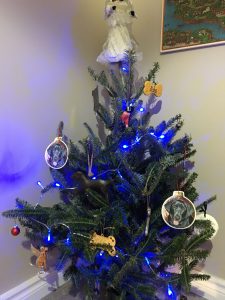 When it comes to Christmas trees, it seems people are either in Camp Real (oh, that fragrance!) or Camp Artificial (oh, so easy).
When it comes to Christmas trees, it seems people are either in Camp Real (oh, that fragrance!) or Camp Artificial (oh, so easy).
For many years, my family was away over the holidays, so for safety’s sake, we went with artificial. And having one, we keep using it. These days, I also buy a real mini “elf tree” (2019 version shown here) because my heart really lies with Camp Real. Yes, those are all dog-related decorations. 🙂
What’s so special about real trees? As The Christmas Tree Farmers of Ontario say, “Nothing says Christmas more than a real tree.”
In 2015, I partnered with my friend, colleague and graphic designer Deana De Ciccio to create a just-for-fun infographic related to real Christmas trees. It includes fun facts like the most popular types of trees, how long it takes to grow an average tree, and places where Canadian trees end up (would you believe Australia and the Caribbean?).
We updated the original version to this “evergreen” version in 2019. Click on the image below and zoom in to read it. Enjoy!
(Post updated for Christmas Tree Day 2020.)


Yes, my family followed the same procedure for Christmas trees for the same reasons. After my mom passed my Dad followed a really efficient process. When Christmas was done, he would take the decorated tree to the basement somehow, draped a sheet over it, and then resurrected it the next year already decorated and dust free.
My childhood Christmases even included a dreaded aluminum tree. I bet that explains a lot.
Here is an interesting use of expired Christmas trees in your backyard:
https://www.cbc.ca/news/canada/toronto/halton-christmas-tree-conservation-1.4966309
Merry Christmas!
Omigosh that’s hilarious — a very efficient process for sure! And thanks for the link. A fitting end for much-loved real Christmas trees. Merry Christmas to you, too!